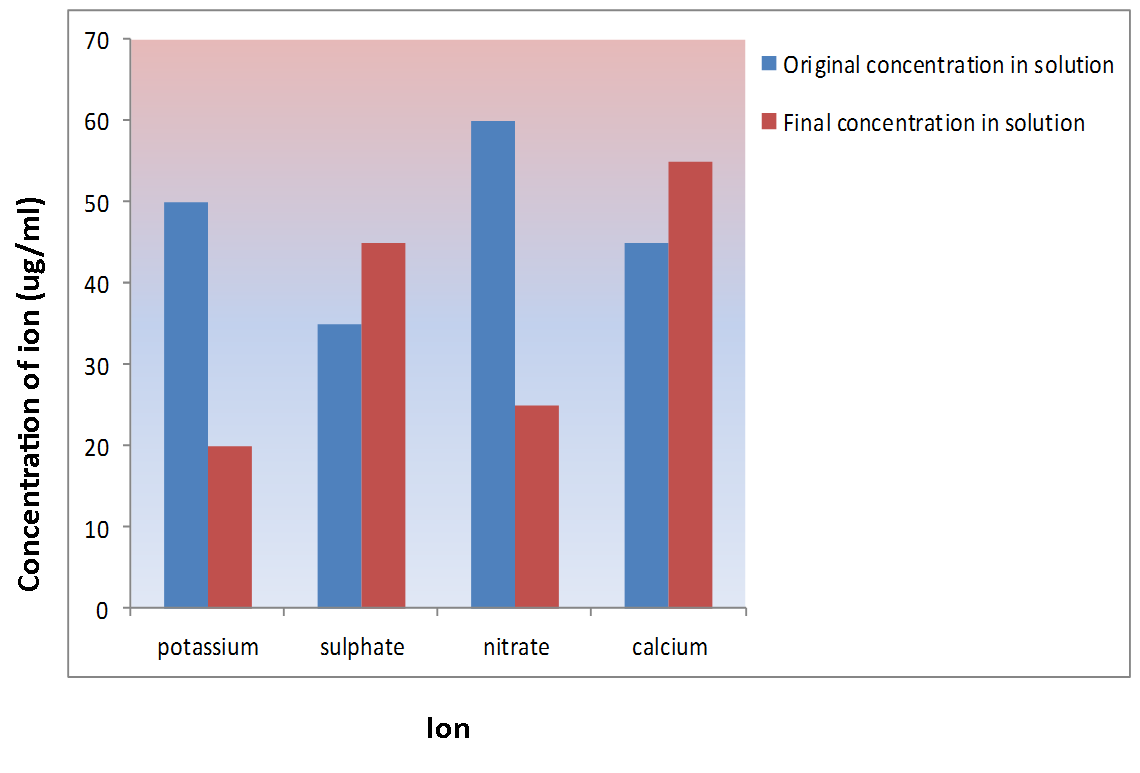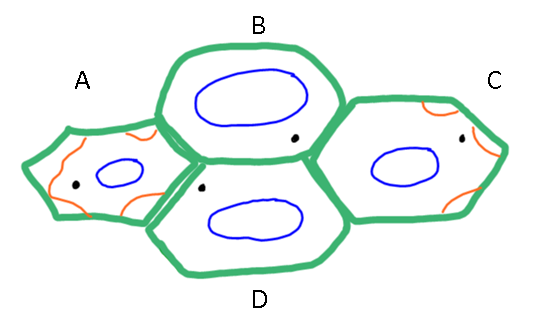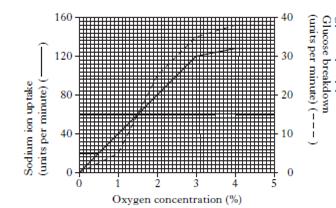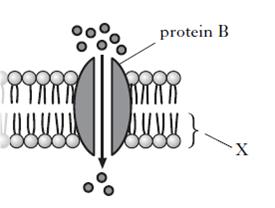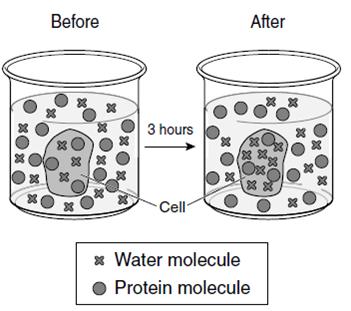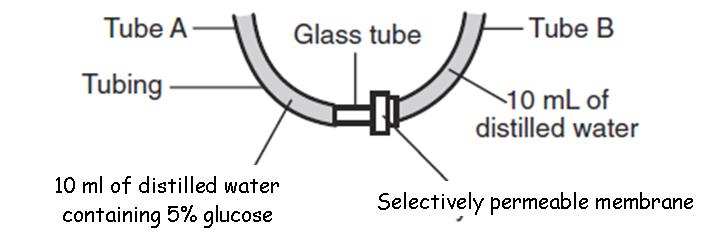| 2. | Substances enter and leave cells by the process of | |
| A. | dissolving | |
| B. | evaporating | |
| C. | breathing | |
| D. | diffusing | |
| 3. | At tissues in the brain which of the following substances diffuse out of the cells? | |
| A. | oxygen | |
| B. | carbon dioxide | |
| C. | nitrogen | |
| D. | glucose | |
| 4. | When an animal cell loses a lot of water its cells would best be described as | |
| A. | plasmolysed | |
| B. | wilted | |
| C. | flaccid | |
| D. | shrunken | |
| 5. | When a plant cell gains a lot of water its cells would best be described as | |
| A. | plasmolysed | |
| B. | flaccid | |
| C. | wilted | |
| D. | turgid | |
| 6. | A piece of potato weighs 20g fresh and 5g dry. What is the percentage water content of the potato? | |
| A. | 5% | |
| B. | 15% | |
| C. | 25% | |
| D. | 75% | |
| 8. |
The following graph shows the changes in the concentration of ions of culture solutions in which barley roots were grown for two days.Which of the ions were both taken up by the plant?
|
||||||
| A. | calcium and sulphate | B. | sulphate and potassium | ||||
| C. | potassium and nitrate | D. | nitrate and calcium | ||||
Use the diagram below and your knowledge of osmosis to answer questions 9 and 10 which follow.
| 9. |
Examine the cells in the diagram. If the cells were to remain in contact as shown, water would pass by osmosis from ……
|
|||||||||||
| A. | C to B | B. | B to D | C. | A to B | D. | C to D | |||||
| 10. |
If the cells were to remain in contact as shown, then water would move by osmosis from …….
|
|||||||||||
| A. | D to C | B. | A to D | C. | D to B | D. | A to B | |||||
| 11. | Carrier molecules involved in the process of active transport are made of | |
| A. | protein | |
| B. | carbohydrate | |
| C. | lipid | |
| D. | phospholipid | |
| 12. | An investigation was carried out into the uptake of sodium ions by animal cells. The graph shows the rates of sodium ion uptake and breakdown of glucose at different concentrations of oxygen.Calculate the number of units of sodium ions that are taken up over a 5 minute period when the concentration of oxygen in solution is 2%.
|
||||||||||||
| A. | 80 | B. | 100 | C. | 400 | D. | 500 | ||||||
| 13. | The phospholipid molecules in a cell membrane allow the | |
| A. | free passage of glucose molecules | |
| B. | self-recognition of cells | |
| C. | active transport of ions | |
| D. | membrane to be fluid | |
| 14. |
Red blood cells have a solute concentration of around 0.9%.Which of the following statements correctly describes the fate of these cells when immersed in a 1% salt solution?
|
|
| A. | The cells will burst | |
| B. | The cells will shrink | |
| C. | The cells will expand but not burst | |
| D. | The cells will remain unaffected | |
| 15. |
Rhubarb epidermal cells have a solute concentration of around 0.9%.Which of the following statements correctly describes the fate of these cells when immersed in a 0.5% salt solution?
|
|
| A. | The cells will burst | |
| B. | The cells will shrink | |
| C. | The cells will expand but not burst | |
| D. | The cells will remain unaffected | |
| 16. |
The diagram shows a protein in the cell membrane of a cell.Identify the process that the protein is carrying out and the molecule X.
|
||||||
| A. | The process is active transport and molecule X is phospholipid | B. | The process is active transport and molecule X is protein | ||||
| C. | The process is diffusion and molecule X is phospholipid | D. | The process is diffusion and molecule X is protein | ||||
| 17. |
The diagram below shows the process of osmosis.Only the water molecules could enter the cell because water molecules —
|
||||||
| A. | have more energy than the protein molecules | B. | are smaller than the protein molecules | ||||
| C. | are more numerous than the protein molecules | D. | contain more hydrogen atoms than the protein molecules | ||||
| 18. | Which sentence best states the importance of using control groups? | |
| A. | Control groups allow comparison between subjects receiving a treatment and those receiving no treatment. | |
| B. | Control groups eliminate the need for large sample sizes, reducing the number of measurements needed. | |
| C. | Control groups eliminate the need calculate averages and simplify calculations | |
| D. | Control groups provide a method by which the chance of a fluke data point can be reduced | |
| 19. |
The diagram below represents a laboratory setup used by a student during an investigation of diffusion.Which statement best explains why the liquid in tube A will rise over a period of time?
|
||||||
| A. | The glucose concentrations are equal on both sides of the membrane. | B. | The water will pass from a region of lower glucose concentration to one of higher glucose concentration | ||||
| C. | Water and glucose volumes are the same in both tubes A and B. | D. | The fluids in both tubes A and B will change from a higher temperature to a lower temperature. | ||||
| 20. | A red onion cell has undergone a change, as represented in the diagram below. This change is most likely due to the cell being placed in
|
||||||||||||
| A. | distilled water | B. | light | C. | salt water | D. | darkness | ||||||


